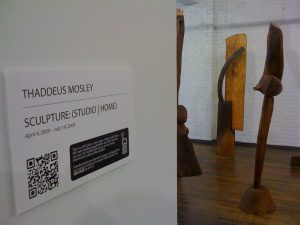QR Codes Enhance Museum Experience
Posted on by Timothy Boyle Most museums, whether they are art, history or any other subject, often times have little more than a paragraph on a plaque explaining the exhibit. If you are not already well versed in the subject at hand you will likely be at a loss for what you are viewing, and hard pressed to learn very much about the subject with the little information being provided to you.
Most museums, whether they are art, history or any other subject, often times have little more than a paragraph on a plaque explaining the exhibit. If you are not already well versed in the subject at hand you will likely be at a loss for what you are viewing, and hard pressed to learn very much about the subject with the little information being provided to you.
The answer to this problem for museums isn’t to post essays on the plaques, besides being an unpleasant look it would also be clumsy, lack engagement and during busy times wouldn’t be very efficient for the museum goers. Instead what museums must do, if their goal is to increase traffic, teach museum goers, or simply improve the museum experience, is to find ways to engage the visitor by providing interesting and relevant information in an exciting, convenient media. Enter the QR code.
The way to accomplish these goals–that is how to drive traffic, help uneducated visitors learn and improve the overall experience–is by allowing museum goers to access information by QR code. This may seem like a simple task at first, and perhaps for those skeptics out there you may even question that it would even work, but there is far more to this then simply posting a QR codes next to an exhibit and having it direct you to a Wikipedia page on the subject at hand. No, for this QR code technology to work the visitor must be directed to media that is engaging, interesting and requires little effort. So what does this mean?
Instead of simply having the QR code direct a person to an article or written source on the subject, the QR code should direct someone to an interactive website, a video on the subject, or an audio tour of the exhibit or particular item. The latter allows for private, free, audio tours for anyone with a smart phone and earphones and can provide far more information than just a small plaque. As visitors enter an exhibit a sign would alert them to the free audio tour on their own personal smart phone upon scanning of the code (instructions on how to do this must be given also). The tour would then guide them throughout the exhibit. Or another great way to engage the visitor, if the visitor wishes not to take a full audio tour, is to have codes provide audio specific to a particular item, or video specific to an exhibit or sub-exhibit. The video would need to be relevant, exciting and maybe five minutes long at most. This would ensure the museum goers were engaged, interested, and learned more than they otherwise would have with just a plaque. As long as the QR code directs the visitor to an interactive and relevant landing page, this should ensure the success of the undertaking.
Many museums around the world have begun to use the QR code technology to improve the customer’s experience, with some doing a much better job than others. A couple great examples are Cleveland Museum of Art , the Bologna Museum of Archeology (along with many other Italian museums) and the Smithsonian Natural History Museum.
Both the Cleveland Museum of Art and the Bologna Museum of Archeology have begun using QR codes that upon scanning allow the visitor to be taken on an audio and video guided tour of particular galleries and exhibits or entire museum tours, greatly enhancing the visitor’s experience.
The Smithsonian natural History Museum have used QR codes in various ways, but one creative, fun, and interactive way was using it as part of their Neanderthals exhibit. Upon scanning the QR code the visitor was sent to a landing page where they could upload a photo of themselves and the site would show them what they would have supposedly looked like some 30,000 years ago. This could then be shared on the various social networks. Of course this isn’t terribly educational, but it is fun and engaging and a way to drive interest and excitement for the museum.
There are all sorts or creative ways museums could use QR codes to drive traffic and improve overall experience for the visitor. But just using QR codes is not enough, a QR code is only as good as the media it is linked to, so one must make sure that the scanning of a QR code is worth the effort or the QR code campaign you are attempting will more than likely end in failure.

